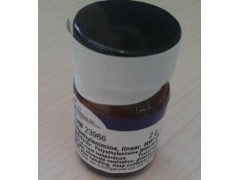Polysciences 23966-2 spot promotion
Suzhou Damaidi Biomedical Technology Co., Ltd. is an authorized agent of polysciences.
support hotline

Founded in 1961, POLYSCIENCES is a leading international manufacturer of specialty products for the pharmaceutical and personal care industries. POLYSCIENCES' main products include specialty and fine chemical reagents, laboratory reagents, monomers, polymers, chemical reagents for microscopy, histology and biotechnology research, as well as photovoltaic materials and other specialty reagents. POLYSCIENCES Polyethylene ***; polymer chain has a methyl group at one end and an amino group at the other end; melting point is 73-75 ° C; can be stored at room temperature.
Polyethyleneimine enhances the adhesion of cells with weak adhesion in cell culture. PEI is a cationic polymer, and the negative charge on the extracellular surface adheres to the bottom surface of the petri dish covered with PEI, providing a stronger adhesion between the cell and the plate. However, polyethyleneimine is highly cytotoxic.
Polyethylenimine is the second polymer transfection reagent found in the history of polylysine. PEI condenses DNA into positively charged particles that bind to negatively charged cell surface residues and enter the cell by endocytosis. Upon entry into the cell, protonation of the amine results in a large influx of counterions and a decrease in osmotic potential. The osmotic expansion caused by the above changes causes the vesicle to release a polyplex formed by the polymer and DNA into the cytoplasm. After the complex is disassembled, the DNA can be freely fused into the nucleus. PEI has strong cytotoxicity. The mechanism of action is divided into two types. One is to cause cell membrane to break (immediately) cell necrosis, and the other is to cause mitochondrial membrane fragmentation after endocytosis, eventually leading to (delayed) cell withering. Die.
Polysciences Polyethyleneimine PEIS has two types:
A linear polyethyleneimine (PEIs) with a molecular weight of 25,000: commonly used as a transfection reagent
The polychain contains up to 7-8% of poly-2-ethyl-2-oxazoline. Order number: 23966-2.
Molecular formula: (C2H5N)x
Molecular weight: 25,000
Melting point: 73-75o
Soluble in: hot water, low pH cold water, methanol and ethanol. Insoluble: ***, ethyl, propyl *** and cold water.
Hazard: Unknown operation: Gloves & Fume hood storage: Room temperature Storage number: U5g - (hazard/handling/storage codes)
CAS No.: 9002-98-6
Modified PEG can be used in the fields of drug delivery, medical device modification and diagnostic analysis. Nanocs offers a wide range of options from phospholipid PEGs to fluorescent PEGs.
The use of PEG-modified
1. Protein-based drug PEG modification: PEG-modified protein drugs can prolong the half-life of the drug, reduce the immunogenicity, and maximize its biological activity. As a therapeutic drug, polyethylene glycol (PEG) modified proteins are more effective than unmodified proteins. The PEG-modified protein drug modification pathway mainly includes amino modification (including acylation modification of N-terminal amino group, acylation modification of lysine side chain amino group, alkylation modification of N-terminal amino group), carboxyl modification, thiol modification, and the like. At present, the research on PEG-modified protein drugs at home and abroad mainly focuses on adenosine deaminase, asparaginase, interferon, granulocyte colony-stimulating factor, interleukin, etc. More than 40 drugs are undergoing clinical research. .
2 , peptide compound PEG modification : peptide compound PEG modification, such as salmon calcitonin, epidermal growth factor PEG modified product half-life and biological activity is significantly higher than the prototype drug. In particular, peptide compounds are easier to achieve than proteins in fixed-point modification of polyethylene glycol. The most common application in the PEG modification study of peptide compounds is mPE.
3 , PEG modified liposome : common immune liposome due to short circulation half-life in the blood, easy to be removed, limiting its development. PEG-modified long-circulating liposomes increase the blood circulation time of liposomes, which not only can escape the capture of the reticuloendothelial system, but also improve the passive targeting of liposomes. It has been widely used in liposome pharmaceutical preparations.
4 , PEG modified organic small molecule drugs : many small molecule drugs, currently with anti-tumor drugs, using PEG modification technology, polyethylene glycol supporting small molecules, can transfer many of its excellent properties to the conjugate The polymer has excellent biocompatibility, can be dissolved in the tissue fluid in the body, and can be quickly excreted by the body without any toxic side effects. Many anti-tumor drugs are modified by high molecular weight PEG to achieve passive targeted administration of tumor tissue.
5. Other applications : PEG-modified affinity ligands and cofactors are used in aqueous two-phase distribution systems for the purification and analysis of biological macromolecules and cells. PEG-modified sugars can be used as new drug materials and drug carriers. Oligonucleotide PEGylation can increase solubility, increase resistance to nucleases, and cell membrane permeability. Biomaterial PEGylation reduces thrombus formation and reduces protein and cell adhesion.
Body Health Diagnosis Device
Shenzhen Guangyang Zhongkang Technology Co., Ltd. , https://www.szlighttherapymachine.com
